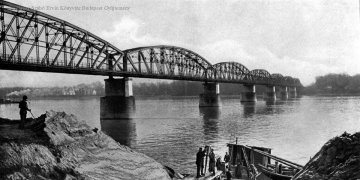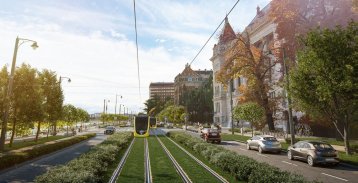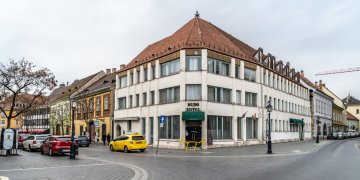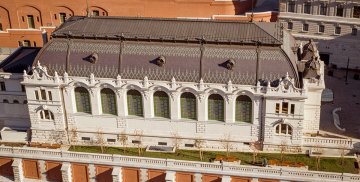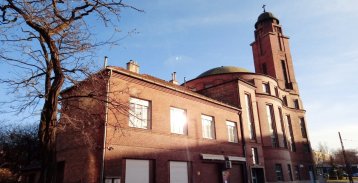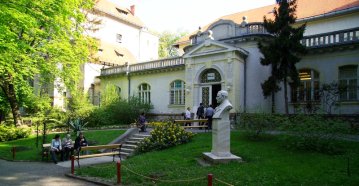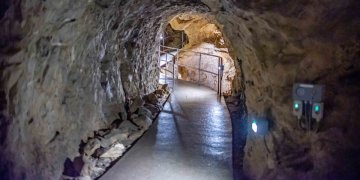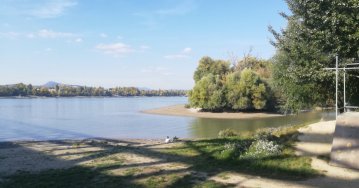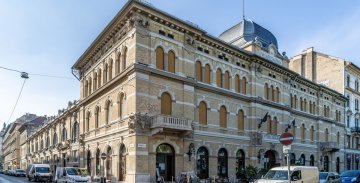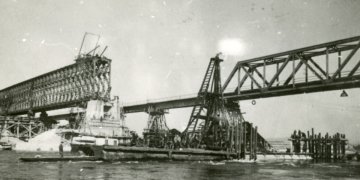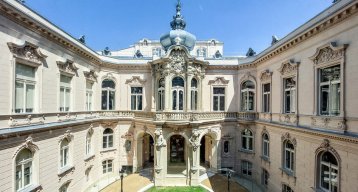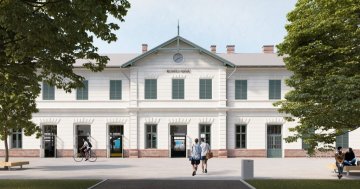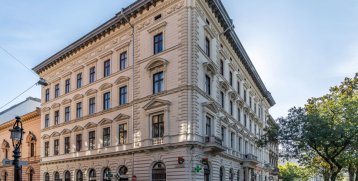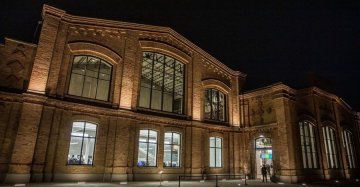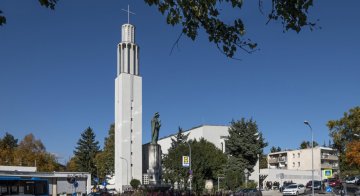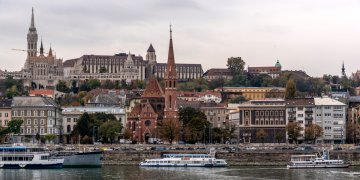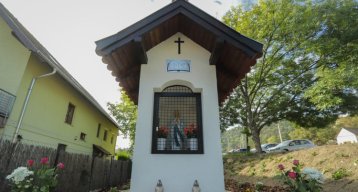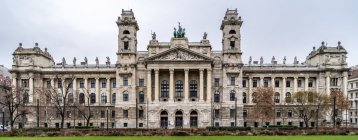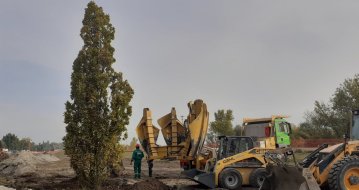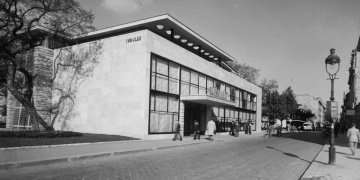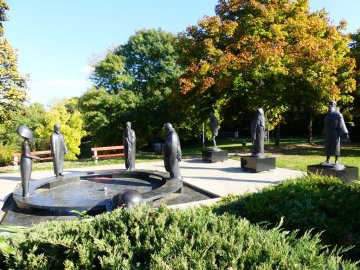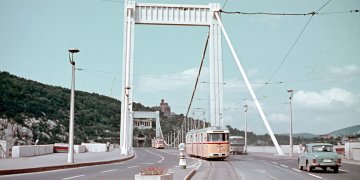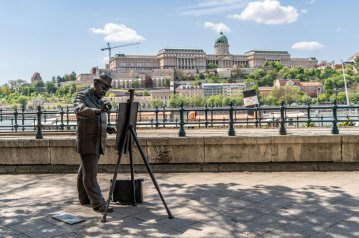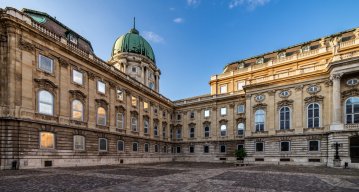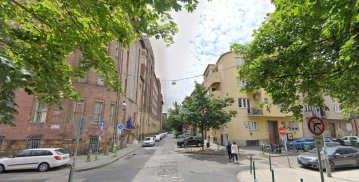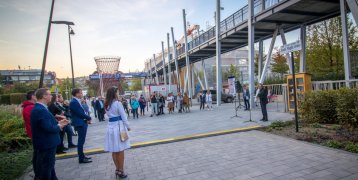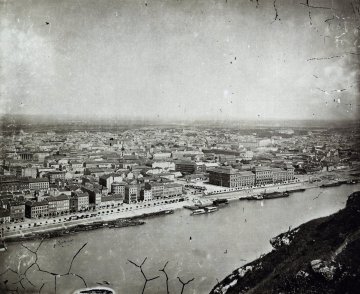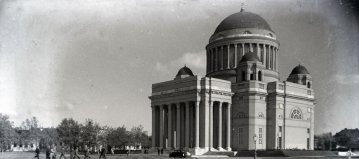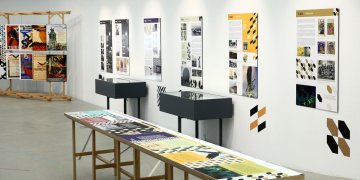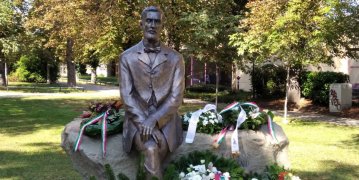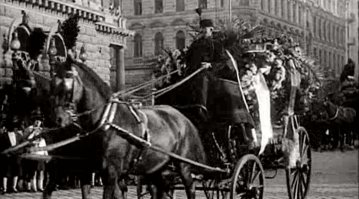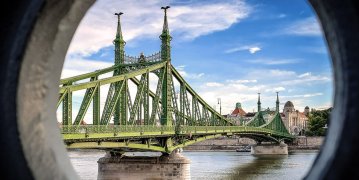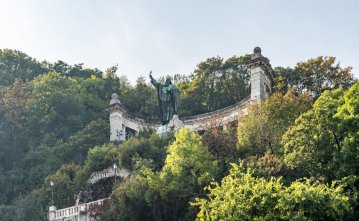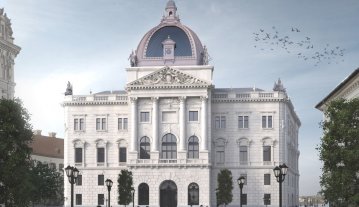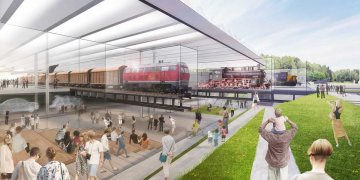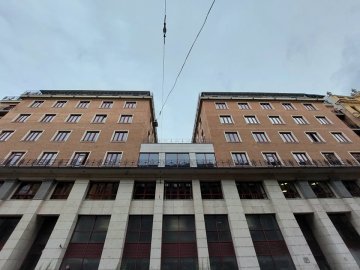 The „intertwined history” of the bridges and the city of Budapest
Which ideas and events have shaped the fate of bridges of Budapest and the cityscape? Alongside many other interesting facts, this question is also answered this newly published book by the Budapest City Archives, which introduces the history of bridges in Budapest.
The „intertwined history” of the bridges and the city of Budapest
Which ideas and events have shaped the fate of bridges of Budapest and the cityscape? Alongside many other interesting facts, this question is also answered this newly published book by the Budapest City Archives, which introduces the history of bridges in Budapest.
Search result
A forgotten enormous railway bridge - Built for the Millennium, destroyed by war
November 7, 2021 at 10:30 AM
The Újpest Railway Bridge is a stepchild among the bridges in Budapest because it does not even have a regular name. There is almost no mention of it, even though trains have been running here for 125 years, and it plays an important role in traffic around Budapest. Pestbuda now remembers the birth of the first structure, which was built in 1896 for the millennium but was destroyed in World War II.
The planning of a new section of the weaving tram network in Buda continues
November 6, 2021 at 6:30 PM
Another milestone was reached in the new section of the tram, and the evaluation permitting and construction plans were completed. Part of the tramway will be grassed and seven new stops will be built.
The Hungarian Chamber of Architects would place 7-8 Szentháromság tér in Budavár under protection
November 5, 2021 at 5:00 PM
In the Buda Castle, the Matthias Church opposite the former diplomatic residence, the later Burg Hotel was built in the 1970s. According to the proposal of the Hungarian Chamber of Architects, the building should be placed under local protection, thus preserving it for posterity.
The roof structure of the Budavár Riding Hall won an international award
November 5, 2021 at 2:00 PM
The recently reborn Riding Hall in Budavár, with its red and green English slate roof structure rebuilt in the same way as the original, won the World Championship of the International Roofing Association in Germany. The building, with its vaulted mansard roof, has earned the recognition in the category of metal roofs.
The Lutheran Church in Kőbánya is ninety years old, the first Protestant building in Budapest showing modern architectural principles
November 5, 2021 at 11:00 AM
The church of the Lutheran Parish of Kőbánya, consecrated in 1931, is located in the geometric center of the capital. The building at 14 Kápolna Street is a small "jewel box" of Hungarian sacred architecture between the two world wars. Its floor plan evokes the world of Baroque sacral buildings with a single nave, and in its external design it can be related to the Western European buildings of art deco.
"Budapest should be made a metropolis" - 150 years ago, the large-scale constructions in the capital were announced
November 4, 2021 at 10:30 AM
The transformation of the Hungarian capital into a metropolis was formulated before the unification of Pest and Buda, when in 1871 a tender was issued for the preparation of a regulatory plan that would provide a framework for the planned large-scale constructions. The tender, which closed 150 years ago, received a number of proposals that contributed to the development of the currently known structure and cityscape of the capital.
Five hundred trees are planted in the Highlands instead of trees to be cut down during the renovation of Korányi Hospital
November 3, 2021 at 8:00 PM
During the renovation of the National Korányi Pulmonology Institute of the 12th district, new trees will be planted in place of the trees to be felled. The institution replaces 200 trees locally and 300 trees are planted in various public areas of the district.
Miracle under Buda - The Szemlő-hegyi Cave can be visited for 35 years
November 1, 2021 at 2:00 PM
Although the Szemlő-hegyi Cave has been discovered for more than 90 years, it has only been open to the public for 35 years. This is one of the most beautiful and interesting underground attractions in the capital, which is a great recognition, as there are several cave specialities below Budapest.
The statue of István Bibó was put back on the upper embankment of Pest
October 30, 2021 at 2:00 PM
The bronze bust of István Bibó was lifted back to its place on the Széchenyi embankment by crane, which was moved due to the ongoing renovation works of the older József Antall embankement.
Where they once dreamed of an Olympics - Time stopped on Népsziget
October 30, 2021 at 9:00 AM
There is a place in Budapest that has almost gained world fame. In the end, however, it did not become world-famous, in fact, it does not even have a regular, honest name. In our current article, we will visit Népsziget [People's Island], which is beautiful even in its severe neglect and underutilization.
The interior of the Hunyadi Square Market Hall will be renovated
October 29, 2021 at 7:30 PM
According to the public procurement, the designer should take into account that the market hall, built in 1897 according to the plans of Győző Czigler, is a protected monument building in a world heritage area.
Intended to be temporary, the structure of the Connecting Railway Bridge built after the war served Budapest until 2008
October 29, 2021 at 10:00 AM
At the end of World War II, a permanent railway bridge over the Danube was rebuilt at record speed. One and a half years after the weapons were silenced in the country, and exactly 22 months after the bridge was blown up, the semi-permanent structure of the Connecting Railway Bridge was already standing, weighing half as much as the Chain Bridge which is much longer than this. Although it was demolished a few years later from its original location, it moved to Újpest, where it served traffic until recently.
Renovation of the Eiffel Workshop and the Károlyi-Csekonics Palace awarded
October 28, 2021 at 4:30 PM
Pro Architectura awards were presented in connection with several buildings in Budapest, the establishment of the Eiffel Workshop, the National Museum Restoration and Storage Center, the renovation of the Károlyi-Csekonics Palace, and the design ceramics restoration tasks of the Udvar Hotel in Paris.
Renovation of the headquarters of the Magyar Nemzeti Bank begins
October 27, 2021 at 6:30 PM
The complete reconstruction of the headquarters of the Magyar Nemzeti Bank in Szabadság Square will start in November. During the works, the damage to architecture and the fine arts caused by post-World War II alterations, thus restoring the original splendor of the building. The end of the renovation is planned for 2024, the 100th anniversary of the founding of the independent Hungarian central bank.
A call has been issued for the renovation of the former station building in Kelenföld
October 27, 2021 at 2:00 PM
The tender for the renovation of the station building of the Kelenföld railway station has been announced, the construction works may start next year. The Transport Museum will create a railway history exhibition space and field table in the house, but a new community space and a café are also planned.
The lively story of the Pucher House - A newspaper was also founded in the house at 53 Andrássy Avenue
October 27, 2021 at 11:30 AM
111 years ago, the idea of one of the typical societal media of the 20th century, Színházi Élet, was born in one of the 3rd-floor rooms of the house at 53 Andrássy Avenue. There were many shops and offices in the building, but nowadays the roof of the building is also interesting. A lot has happened in the last 135 years with the roof of the residential house on the corner of Andrássy Avenue and Eötvös Street - the most recently completed attic installation got an occupancy permit.
The Eiffel Workshop has been opened
October 26, 2021 at 3:00 PM
The Eiffel Workshop of the Hungarian State Opera House was officially handed over, and a total of 33,000 square meters and a 3-hectare park of the institution were renewed. The new cultural center opens up a great opportunity for opera performance.
The restored Franciscan church, parish and community house in Pasarét were inaugurated
October 25, 2021 at 3:00 PM
The Franciscans of Pasarét renovated the monastery and church in the Parish of St. Anthony of Padua and created a new, modern community parish building. The church of Pasarét, designed by Gyula Rimanóczy Sr., was consecrated in 1934 and most recently underwent major reconstruction in the 1980s.
The pentagon of the Buda bank of the Danube - Pestbuda visited the completely renovated church of Szilágyi Dezső Square
October 21, 2021 at 10:30 AM
The Szilágyi Dezső Square Reformed Church was taken over by the faithful on Palm Sunday of 1896, so this year it celebrated the 125th anniversary of its construction. The Parish kept track of the anniversary and two years ago began the interior renovation of the building, which was largely completed in March. Due to the month of architecture - and as the Reformation Day approaches - Pestbuda was able to see what the new interior became like.
The shrine of the Virgin Mary in Békásmegyer-ófalu was rebuilt
October 20, 2021 at 2:00 PM
The shrine of the Virgin Mary, built in the 18th century and later demolished in Békásmegyer-ófalu, has now been rebuilt on the initiative of the local traditional association.
A worthy plot of land for the Palace of Justice has been found opposite the Parliament - The building of the Curia is 125 years old
October 20, 2021 at 9:00 AM
Recently, the name of Alajos Hauszmann has been in the public consciousness, mainly as an architect of the Royal Palace, due to the constructions in the castle, but many other works are also connected to his name in Budapest. One of his most notable and most successful works is the building of the Curia in the Kossuth Square, which was handed over just 125 years ago, on 20 October 1896, in a ceremonial setting, as part of the millennium celebrations.
They planted a 25-year-old oak tree in Pünkösdfürdő Park
October 19, 2021 at 2:00 PM
Gardening work began on the banks of the Pünkösdfürdő Danube, 3rd district. A huge 25-year-old oak was planted in Pünkösdfürdő Park on Monday, 18 October.
The Erzsébet Square bus terminus in the middle of the city centre had been closed for 20 years
October 19, 2021 at 10:30 AM
The Erzsébet Square bus station has not departed and accepted buses for twenty years now. For much of the 20th century, it was still natural for buses to depart from central spaces that were easily accessible to all, but due to changes in urban development considerations, bus stations were pretty slowly pushed out of the inner city core. The Erzsébet Square bus station in the 5th District was also closed down.
The Garden of Philosophy was inaugurated on Gellért Hill 20 years ago
October 18, 2021 at 10:00 AM
The sculpture composition called Garden of Philosophy has been standing on Gellért Hill for twenty years now. The work, which depicts the world's leading thinkers and founders of world religions, was donated to Budapest by Nándor Wagner, a sculptor of Hungarian origin living in Japan.
The roaring Bengali - The first articulated trams were not a success in Budapest
October 17, 2021 at 9:00 AM
By the end of the 1950s, the existing trams in Budapest proved to be increasingly too small, so a new, more accommodating, articulated tram was built by Hungarian engineers, the Bengali. The recipe was simple, the type was spacious and shapely, yet the first articulated trams that appeared in Budapest were not clearly successful.
In the footsteps of our famous painters - Artist sculptures in Budapest
October 16, 2021 at 2:00 PM
On the occasion of the Hungarian Artists Day on 18 October, we followed in the footsteps of Budapest's artist sculptures: we show how the famous artists live in the memory of the capital, which painters' memories were preserved, why and how.
The first post-war domestic flight departed from Budapest 75 years ago
October 15, 2021 at 9:00 AM
Reconstruction after World War II also extended to transport networks. On the one hand, the railway also suffered from the war, and on the other hand, the existing capacities were tied up in the reconstruction, so part of the passenger transport was solved by planes. Domestic flights were launched on 15 October 1946 by Malév's predecessor, the Maszovlet company, and the first two planes could travel from Budapest to Debrecen and Szombathely.
We can learn about the history of the Buda Castle in the renewed exhibition of the Castle Museum
October 14, 2021 at 9:00 PM
A number of recently discovered works of art, building elements, photographs and other documents are presented in the renewed permanent exhibition in the Castle Museum, which reviews the modern history of the Buda Castle. A 3D reconstruction of the three eras of the palace can be seen: the animations evoke the states created by the medieval, Baroque and Haussmannian expansions. A new temporary exhibition on the relocation of sculptures during the change of regime "Can Ostapenko stay?" can also be seen.
By mid-December, the Southern railway connecting bridge could be fully completed
October 13, 2021 at 7:00 PM
The closing piece of the steel structure of the new, Southern railway connecting bridge was added, thus completing the next phase of the renovation and expansion of the Danube railway bridge. According to the plans, from mid-December, trains will be able to run over the Danube on the two new bridge structures.
Gyorskocsi Street in Buda preserves the name of a special means of transport
October 13, 2021 at 10:00 AM
Gyorskocsi Street in Buda preserves the history of the means of transport used in the 18th-19th century, before the spread of the railway, which made it possible to get from Buda to Vienna and back in the shortest time. But what was that particular gyorskocsi [diligence or stagecoach] like, who travelled by it, and how long did the trip take? You can read about that here.
A promenade was named after Magda Szabó in Buda
October 12, 2021 at 10:30 AM
On the writer's birthday, on 5 October, the street sign of the Szabó Magda promenade was inaugurated in the 2nd district, in the area between Mammut Shopping Center and Széllkapu Park. There is also a bookcase on the promenade that anyone can add to and anyone can read from.
Once upon a time there was a boy's orphanage - Josephinum designed by Mihály Pollack got its name from Palatine Joseph¬
October 10, 2021 at 10:00 AM
The support and upbringing of young children who lost their parents, and the satisfaction of their daily needs in Hungary until the middle of the 18th century was undertaken by the churches. The first city orphanage opened in Kőszeg in 1741, and then in the following decades similar institutions maintained and operated by the settlements were built in Selmecbánya [today Banská Štiavnica], Sopron, Nagyszombat [today Trnava] and Veszprém. In Pest, although prominent citizens donated significant sums for this purpose in the 1790s, only 100 years after the opening of the one in Kőszeg was the foundation stone of the first educational institution of this type laid, and it named after Palatine Joseph.
When cyclists were also taxed in Budapest
October 9, 2021 at 11:00 AM
Budapest found itself in a difficult financial situation 115 years ago. Although cyclists and dog keeping were already taxed, water fees and tuition fees were raised, in 1906 it became clear that this was not enough to overcome the huge budget deficit. The government did not approve the planned additional tax burdens (such as the champagne tax and the card tax) and the new tax increases, but provided budget support to settle the capital's debt.
One of the largest churches in Budapest was consecrated ninety years ago
October 8, 2021 at 9:00 AM
The Church of Our Lady of Hungary in Rezső Square, consecrated on 8 October 1931, became the second largest church in the capital after St. Stephen's Basilica. Although it has since been toppled from this eminent place, it is still at the forefront to this day. However, not only is its size commanding authority, but also the long and tacit history of its construction.
A turul history exhibition opened in Hegyvidék
October 6, 2021 at 5:00 PM
The history of the turul bird as a symbol is presented in an exhibition at the Hegyvidék Gallery. The exhibition explores the history of the turul from original Árpád-era roots through millennium celebrations and arrow terror to the present day with the help of original documents, artefacts and images.
A statue was erected for Loránd Eötvös, who served universal science with a Hungarian heart
October 6, 2021 at 2:00 PM
One of the most famous Hungarian scientists is immortalised in many reliefs and busts in Budapest, but previously he only had one life-sized statue: it was erected in 2016 in Pest, in front of the central building of the University named after him. Now a new statue has been placed in the Gesztenyés Garden in the 12th District of Buda, and the place is closely connected to him as well: his most famous invention, the torsion pendulum was produced in the predecessor of the Hungarian Optical Works operating next door.
The eternal flame has been burning for ninety-five years at the execution site of Lajos Batthyány
October 6, 2021 at 9:00 AM
As early as the 1870s, it was decided that a memorial would be erected to Lajos Batthyány, who was executed in 1849, but while other statesmen received a statue, the martyrdom of the Prime Minister was commemorated with an eternal flame. The monument was built in 1926, and the inauguration of the eternal flame, which still stands today, took place on the day of the execution, on 6 October, with the participation of Governor Miklós Horthy and several public dignitaries.
The greatest Hungarian tragedienne, Mari Jászai died 95 years ago
October 5, 2021 at 8:00 PM
She was the grande dame of the National Theatre: from 1872 until she died in 1926, with a one-year omission, she was a member of the most important Hungarian theatre for a total of 53 years. She became a member of the company on Kerepesi Road (today's Rákóczi Road), she moved with them to the building of the People's Theatre, when the previous place was ordered to be demolished. Blaha Lujza Square eventually became the real home of the National and Mari Jászai, she was laid in state here and was accompanied from here on her last journey when she died 95 years ago.
Renovation of the Ganz Ábrahám Foundry Collection building can begin
October 5, 2021 at 4:00 PM
The Ganz Ábrahám Foundry Collection building received the necessary permits for the modernization plans. All the monumental elements of the building will be saved and renovated, there will also be a new conference and event space, and a new, wider exhibition of industrial history will be created. The museum garden will also be open to the public.
Miracle in green: Liberty Bridge, one of the most beautiful ornaments of Budapest, is 125 years old
October 4, 2021 at 9:00 AM
Liberty Bridge is 125 years old. Budapest's shortest Danube bridge hides many interesting things. At the time of its handover, in the year of the millennium, Franz Joseph hammered the last silver rivet in, its colour has been blue and gray in addition to green, they wanted to demolish it once, and at its renovation before the regime change they placed back the historical Hungarian coat of arms cunningly.
The House of Creation was demolished 85 years ago
October 3, 2021 at 10:00 AM
One of the famous buildings in Buda was the House of Creation (Teremtés-ház), which later, as House of Formation (Alkotás-ház), gave the name of the street. On the facade of the house was a relief called Creation, which was considered one of the most beautiful works in all of Buda. The work probably owes its existence to Haydn's oratorio, The Creation, presented in 1800 at the Buda Castle. The building was demolished 85 years ago and replaced by a six-story house. On the occasion of the anniversary, Pestubda presents the history of the former famous building.
Trams from Hanover have been operating in Budapest for 20 years
October 2, 2021 at 4:00 PM
After a long time in the rich tram park of Budapest, the first vehicles manufactured in Western Europe were the trams from Hanover with their characteristic opening staircases, which were put into traffic for the first time on 3 October 2001.
The colonnade of the statue of St. Gellért is being renovated
October 2, 2021 at 12:00 PM
The reconstruction of the column surrounding the statue erected in 1904 will be carried out by the Budapest Gallery, and the works are expected to last until the end of the year. In addition, the Monument to the Displaced and the 56th Memorial Column in Tabán will be renewed.
The tomb of Ferenc Erkel was renovated in the cemetery on Fiumei Street
October 1, 2021 at 4:30 PM
The composer's now renewed tomb was erected in 1904 by the Budapest Philharmonic Society. The reliefs created by Ede Kallós show the beats of Erkel's masterpiece, the Hymn.
The National Theatre operated in Hevesi Sándor Square for 34 years
October 1, 2021 at 12:30 PM
When the old building of the National Theatre on Blaha Lujza Square was blown up on 15 March 1965, no one would have thought the institution would operate in a temporary location for three and a half decades. The National Theatre held its opening performance on 1 October 1966, in the building of the former Hungarian Theatre on Hevesi Sándor Square, and until 2000, it was the home of the company.
Reconstruction of the Honvéd High Command building in Buda Castle begins
September 30, 2021 at 4:00 PM
The torso of the Honvéd High Command, originally designed by Mór Kallina, located on Dísz Square, will regain its original form during the reconstruction, and its useful area will more than triple. In the future, it will function as a visitor center, the cultural and tourist gateway of the Buda Castle district.
The Budapest General Assembly decided on the sale of real estate, street names and homeless care
September 30, 2021 at 10:00 AM
For five billion forints, the capital is selling the huge plot at 357 Bécsi Road, in the 12th district a park is being named after Alaine Polcz, and in Kispest, another after Aladár Pege. Homeless care is also expanding, new places have been created in the building of the Gyáli Road hostel, which has recently been returned to the management of the city.
The investment in the new Transport Museum will be accelerated - Preparatory work may begin next year
September 29, 2021 at 2:00 PM
From 2022, the Northern Vehicle Repair will officially become the home of the Hungarian Museum of Technology and Transport. They are bringing forward the necessary demolition, environmental remediation of contaminated soil and reconstruction of some smaller buildings. Reconstruction of the Diesel Hall into a museum could begin in 2023.
Modern, yet traditionally Hungarian - the Church of St. Michael in Albertfalva is 80 years old
September 29, 2021 at 10:00 AM
September 29 is the feast of St. Michael the Archangel, the most popular, most often depicted angel. He was elected patron of several churches in Budapest, the youngest of which was the parish church of Albertfalva, consecrated in 1941. The modern, yet traditionally Hungarian building has recently been expanded with a new community house.
Simon Tolnai, the Hungarian press magnate built a press empire from scratch in Dohány Street
September 28, 2021 at 9:30 AM
Pestbuda rarely reveals behind-the-scenes secrets of their editorial staff, now they make an exception: when researching the past of Budapest, journalists often look for information or photos in the Tolnai Világlapja newspaper. The first issue of the newspaper was published 120 years ago, on 28 September 1901. Its founder, Simon Tolnai, built his huge press empire from scratch, centred first in the demolished Orczy House on Károly Boulevard and then in Dohány Street. The latter still stands today, operating as an office building.
 The „intertwined history” of the bridges and the city of Budapest
Which ideas and events have shaped the fate of bridges of Budapest and the cityscape? Alongside many other interesting facts, this question is also answered this newly published book by the Budapest City Archives, which introduces the history of bridges in Budapest.
The „intertwined history” of the bridges and the city of Budapest
Which ideas and events have shaped the fate of bridges of Budapest and the cityscape? Alongside many other interesting facts, this question is also answered this newly published book by the Budapest City Archives, which introduces the history of bridges in Budapest.
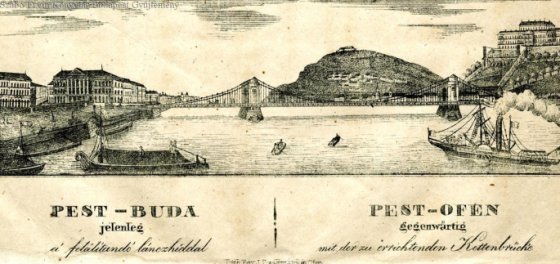 The Bridge Report, which brought a turning point in the history of Budapest
A travel report that changed the history of Pest and Buda, as well as Hungary. The little book contributed to the change of half a thousand years of legal customs and the implementation of an investment of unprecedented size and technical quality. This book was The Bridge Report [Hídjelentés in Hungarian].
The Bridge Report, which brought a turning point in the history of Budapest
A travel report that changed the history of Pest and Buda, as well as Hungary. The little book contributed to the change of half a thousand years of legal customs and the implementation of an investment of unprecedented size and technical quality. This book was The Bridge Report [Hídjelentés in Hungarian].
 Drama on the university wall - The heroic monument was planned 95 years ago
In the constant hustle and bustle of the Egyetem Square in Pest, the students may not even notice the monument that decorates the short section of wall between the church and the central building of ELTE. However, it commemorates their predecessors, the heroes who fought for their country in World War I, and those who heroically helped them. The first design of the dramatically collapsing soldier was born in 1928, ninety-five years ago.
Drama on the university wall - The heroic monument was planned 95 years ago
In the constant hustle and bustle of the Egyetem Square in Pest, the students may not even notice the monument that decorates the short section of wall between the church and the central building of ELTE. However, it commemorates their predecessors, the heroes who fought for their country in World War I, and those who heroically helped them. The first design of the dramatically collapsing soldier was born in 1928, ninety-five years ago.

